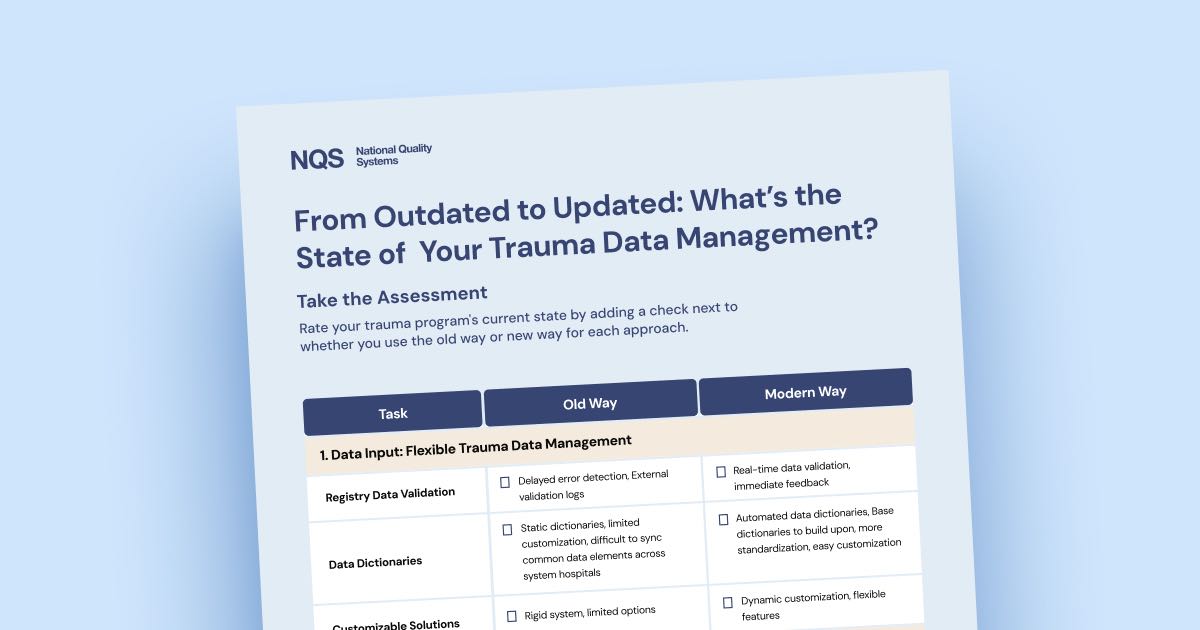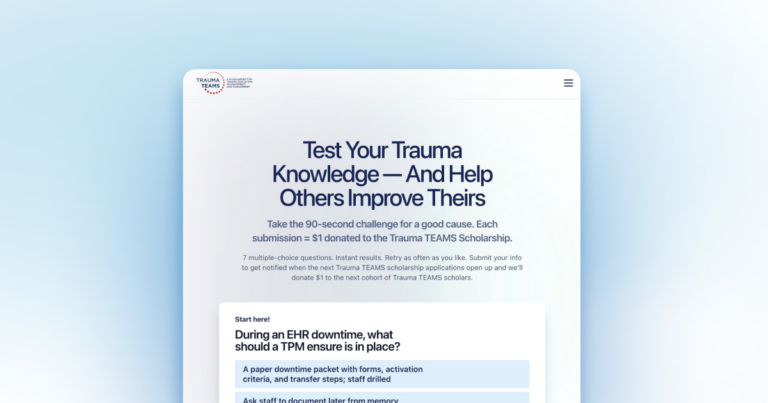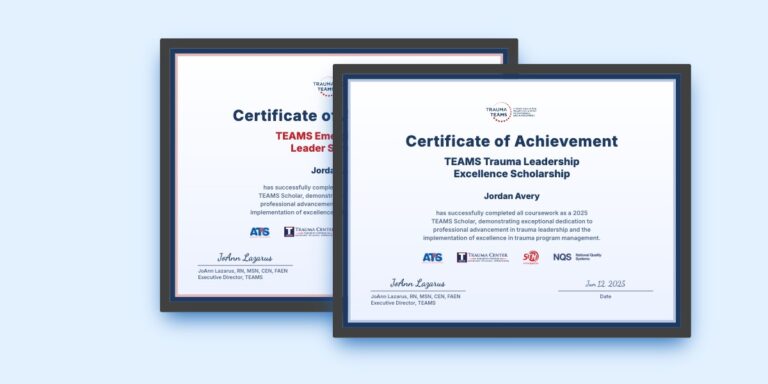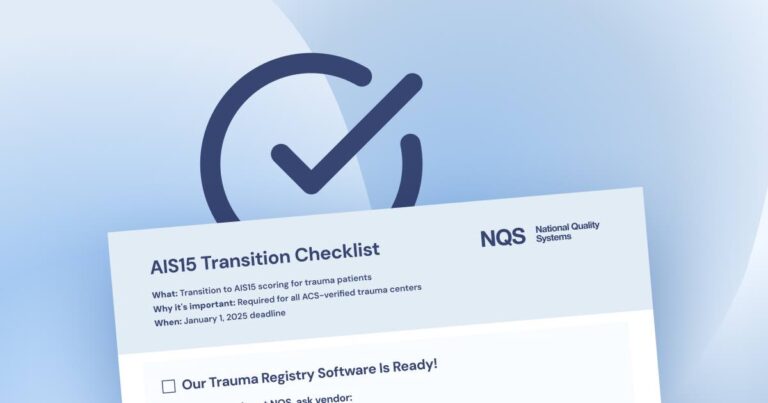

Software, data management, and team performance are seeing rapid improvements across many industries. Now these battle-tested advancements are transforming trauma data management.
Manual processes become streamlined workflows. Siloed, stale data transforms into real-time, connected information. The entire trauma team – from registry and PI to trauma surgeons and providers – can collaborate with less friction.
But modern software approaches alone aren’t enough. Solutions thrive when they pair powerful technology with dedicated people who ensure users are successful.
Let’s dive in…
Let’s explore how these latest approaches are reshaping trauma data management in 2025…
Table of Contents
- Data Input Management
- Real-Time Registry Validation
- Automated Data Dictionaries
- Customizable Solutions
- Data Analytics & Reporting
- Real-Time Performance Monitoring
- Interactive Dashboards
- Geospatial Analysis
- Dynamic Reports
- Team Workflows
- Modern Task Management
- Automated Data Entry
- Team Collaboration
- Implementation & Customer Success
- Software Usability
- Customer Support
- Training Resources
- Financial Data Management
- Revenue Management
- See How Your Facility Scores via The Assessment
1. Data Inputs: Flexible Trauma Registry Data Management
Real-Time Registry Data Validation
Ensuring accurate registry data entry and compliance with national standards is crucial for trauma registries.
Traditional Approach
- No in-app alerts during data entry
- Manually hunt through data fields to find fields needing correction
- Have to wait for vendor validation rules updates, often getting in line behind other hospitals
- May take months to access updates, therefore have to manually validate months of data
- External validation logs
Modern Approach
- Real-time validation messages while doing data entry
- Ability to jump directly from error messages to fields needing correction
- In-app validation logs
- Immediate updates to validation rules
- Automatic validation at the end of chart completion (coming soon)
We had to wait for validation updates from our registry vendor… If you were at the end of the line, then you may be waiting until the end of the 1st quarter before you even got that update…
– Trauma Program Manager on approaches to validation updates
The new way… you get real time updates, so we don’t have to wait for our vendor to update our registry. It’s already updated.
Automated Data Dictionaries
Consistent definitions and validation rules are essential across teams.
Traditional Approach
- Limited to National Data Dictionary (NTDB) and state dictionaries
- Difficult to interpret field meanings
- Required lengthy education to understand definitions
- Many facilities lacked system or facility-specific dictionaries
- Difficult to sync common data elements across system hospitals
Modern Approach
- Base-level data dictionary provided with ability to append facility-specific elements
- Default packages for state and regional requirements
- Simple addition of custom elements
- Dynamic platform for quick modifications
- Standardization of data element documentation
If there is a common theme among multiple hospitals in multiple states, it can be brought forth to say, ‘Hey, is this something that everybody’s collecting? Do you want to switch it to this common element so that it can be tracked across your system?’
VP of Customer Success & Support on standardizing data elements
Customizable Solutions
Modern trauma registry software must adapt to each organization’s unique needs.
Traditional Approach
- Limited customization options
- Rigid pricing structures
Modern Approach:
- Dynamic systems allowing quick changes
- Easy addition of custom data elements
- Flexible report creation
- All-inclusive pricing
- Integration capabilities with multiple programs
- Compatibility with state and ACS requirements
The old way was that you requested additions from the vendor, potentially pay, and possibly some of the updates get rejected. They said. ‘Oh, we’re not going to do that…’
– Sr Product Manager on approaches to handling data elements
The new way is, the vendor provides them with everything that they need for compliance… such as default packages for every state. But they can also go in and add their own custom elements at will. They can select and remove additional optional elements at will. “
2. Data Outputs: Real-time Trauma Data Analytics to Drive Performance Improvement
Real-Time Performance Monitoring
Immediate access to performance data enables faster improvements.
Traditional Approach
- Data often 1-3 months behind and after discharge
- Manually run reports for new insights
- Delayed response to improvement opportunities
Modern Approach:
- Real-time performance data
- Automatic dashboard updates
- Ability to address issues while patients are still in hospital
- Better outcomes through immediate feedback
We need to have the change when the patient’s in the hospital, not when they’re discharged, and say, ‘Oh, next time we won’t do this.’ Because then you have to reevaluate next time.
– Trauma Program Manager on delayed vs real-time data
If you can fix it when it happens versus fixing it a month or two later, you’re going to have better outcomes for the patient.
Interactive Dashboards
Analytics drive performance improvement initiatives and help centers understand their effectiveness.
Traditional Approach
- Highly manual process including the exporting to Excel
- Manual creation of pivot tables, charts, graphs
- Reports weren’t visually appealing, requiring manual formatting
- Process needed repeating for each new time range
Modern Approach
- Ready-to-use dashboards such as master registry, registry compliance, PI, OPPE and more
- Real-time data updates
- Can change parameters on the fly during presentations
Geospatial Analysis
Understanding geographic patterns helps target prevention efforts.
Traditional Approach
- Limited ability to analyze injury patterns geographically
- Have to export data to external BI tools for mapping
Modern Approach
- Built-in mapping capabilities
- Can visualize mechanism of injury locations
- Helps injury prevention teams target interventions
- Ability to track program effectiveness in specific areas
For injury prevention programs, it’s a great asset because you can target an area to say, ‘Hey, the gun violence is here,’ or ‘Hey, this is a hotspot for car accidents.’
– Trauma Program Manager on modern dashboards with mapped injuries
Interactive, Dynamic & Automated Reports
Reports must communicate complex data effectively to various stakeholders.
Traditional Approach
- Cumbersome report creation process
- Required extensive training
- Time-consuming process, possibly full week of preparation for hour-long meetings
- Difficult to get data approved for IRB
- Manual rebuilding for each new report
Modern Approach
- Significant pre-built reports and queries
- User-friendly query builder
- Pre-built graphs
- Generate interactive annual reports
- Presentation-ready, de-identified reports
- Scheduled report generation
- Easy updates to existing reports
- Quick parameter changes during meetings
It takes you a full week to put together this meeting that lasts one hour…
– Trauma Program Manager on modern, presentation-ready reports
So if we can pull these reports, and it’s presentation ready. And it’s: ‘Yes, this is what I want for this meeting’ and just click and drag it over there. It’s going to be a time saver for sure and a stress reducer for people like me.
3. Streamlining Registry & PI Team Workflows
Modern Task Management
Managing trauma cases requires coordinated efforts between team members.
Traditional Approach
- Paper lists translated to Excel spreadsheets
- Email-based assignments
- Relied on registrars tracking their own cases
- Some used REDCap or shared drives
- Required re-opening individual patient cases to see details
Modern Approach
- Integrated registry & PI worklists updated in real-time
- Can assign cases to specific registrars & PI coordinators
- TPMs have visibility across all cases
- Registrars & PI coordinators see their assigned cases
- Track and manage status updates
- Built-in metrics
Integrated worklists, updated in real time based on open registry cases, can be assigned to registrars while lead registrars and admins can view all cases, their statuses and key metrics. Jr members can only view and edit their own records.
– Sr Product Manager on modern approaches to registry & PI case management
And not just for registry. PI teams have workflow tools too.
It creates increased visibility and efficiency for the whole team.
Automated Data Entry
Integration with EHR systems for efficiency.
Traditional Approach
- Often 100% manual data entry due to EHR integration costs
- Basic EHR integrations limited to demographics
- Clunky processes prone to errors
- Inflexible if EHR changes
Modern Approach
- Industry-standard FHIR transactions
- Intuitive import workflows
- Pulls demographics, labs, vitals, provider info
- Preserves manually entered data
- Hospital-defined automation rules
- Registrar override capabilities
Pull over so much more data than just your basic demographics. Labs, vitals, doctors on the case, your trauma activation time…
– Trauma Program Manager on legacy vs modern EHR integrations
4. Getting Help Managing Your Trauma Data
Intuitive Software Usability
The fundamental usability of the software impacts how much training and support users need.
Traditional Approach
- Clunky systems that are hard to understand and use
- Requires extensive training to accomplish basic tasks
- Frequently need to submit support tickets to figure out how to do things
- Updates complex, prone to error and time-consuming
- Getting work done slow and frustrating
Modern Approach
- Software designed to be intuitive and easy to understand
- Built-in guidance and clear workflows
- Users accomplish tasks faster with less training
- Fewer support tickets needed for basic operations
- Updates are streamlined and user-friendly
Dedicated Support Teams
Trauma teams need reliable, knowledgeable support for their registry & PI operations.
Traditional Approach
- Ticket-based system with slow, robotic email responses
- Week or two wait times for responses
- No ability to chat live with a human, such as via a site chat
- Software sometimes doesn’t work at all
- Even longer delays during submission times or updates
- No guidance when new people step into roles
Modern Approach
- Fast response times
- Quick issue resolution
- Available 7 days a week
- Real-time human communication
- Live chat options
- Direct access to support staff
- Staff understand software as well as registry & PI
- White glove approach to support
When you email, it’s a robot, and when you put in a ticket, sometimes it’s a week or two before they get back to you.
– Trauma Program Manager on outdated approaches to software support
Proactive Customer Success Teams
Trauma programs need proactive assistance to be most successful.
Traditional Approach
- Little or no proactive customer success support
- Reactive issue-handling only
- Limited strategic guidance
- No optimization assistance
Modern Approach
- Regular touch-base meetings
- Strategic advice for optimization
- Workflow improvement assistance
- Proactive feature education
- Focus on client goals and success
- Partnership approach to improvement
Flexible Training Resources
Teams need flexible, accessible training options.
Traditional Approach
- Costly training programs
- Requires large group attendance
- One-size-fits-all approach with limited format options
- Extra charges for basic training
Modern Approach
- Multiple training formats:
- On-demand videos
- Sandbox environment
- Presentations
- Virtual training
- In-person training
- Reference documentation
- Learning Management System (LMS)
- Cost included in software
- Accommodates different learning styles
- Self-paced options
- Comprehensive knowledge bases
Proactive Communication
Programs need advance notice of system changes and maintenance.
Traditional Approach
- Unexpected downtime
- Limited communication about updates
- Reactive issue notification
- No systematic maintenance schedule
Modern Approach
- Ample notice for updates and maintenance
- Increased communication for urgent items
- Proactive system checks
- Clear maintenance schedules
- Philosophy of partnership
- Collaborative environment
User Feedback Integration
Software should evolve based on user needs and experiences.
Traditional Approach
- Limited user input into development
- One-way communication
- Static feature sets
- Slow response to user needs
Modern Approach
- Active incorporation of user feedback
- Regular feature updates based on user needs
- Collaborative product development
- Community-driven improvements
The goal is to partner with clients to improve patient care and create a collaborative environment to utilize the expertise of our clients.
– VP of Customer Success and Support on working with customers to improve
5. Financial Data Accuracy
Integrated Financial Tracking
Accurate financial data is crucial for trauma center sustainability and resource allocation.
Traditional Approach:
- Disconnected financial and clinical data systems
- Manual reconciliation processes
- Limited visibility into trauma-specific costs
- Delayed financial reporting
- Difficulty tracking trauma-specific revenue
Modern Approach:
- Integration of financial data with registry systems
- Real-time cost tracking
- Improved accuracy in trauma-specific financial metrics
- Better visibility into resource utilization
- Enhanced ability to demonstrate program value
- Streamlined billing workflows
Bonus: Subscribe to Trauma Data Management Software
Buying & Updating Trauma Software
The approach to purchasing and updating trauma registry software has evolved significantly.
Traditional Approach:
- Limited vendor options
- High-pressure tactics
- Feeling “locked-in”
Modern Approach:
- Competitive market with multiple options
- Focus on demonstrating features and capabilities
- Recognition of importance of happy customers and word-of-mouth
How Does Your Facility Score? Take the Assessment
We’ve put together a simple, confidential pdf assessment for you to see how your facility scores on the maturity scale of trauma data management. How modern are your systems?

Conclusion
The evolution of trauma data management reflects a broader shift toward more intuitive, efficient, and collaborative approaches. While automation and modern tools are transforming how we work, the core focus remains on data accuracy and quality.
As one experienced registrar noted, “You always have to double check your data before you generate anything.”
These new approaches aim to make that verification process more straightforward while maintaining the high standards required for trauma care improvement.
This post is part of a series on trauma data management innovations. Watch for deep dives into each of these topics in future posts.




